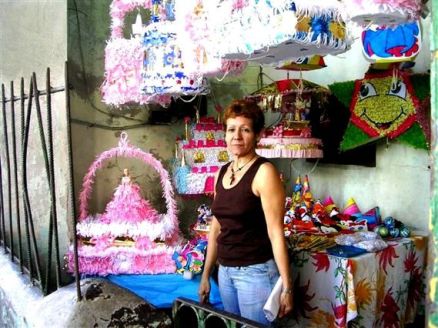Yailenis Mulet Concepción
Volume 37, 2016 – Issue 9
Original Article: SELF-EMPLOYMENT IN CUBA: THE CASE OF SHOE MANUFACTURING
Abstract
This article discusses the phenomenon of self-employment in Cuba from three perspectives: its conceptualisation, its links with informality and the challenges to its growth. First, it reviews the characteristics of self-employment in Cuba, in comparison with available theory and with various studies of informality carried out in other countries. Second, it documents the dimensions of informality and Cuba’s black market economy through the study of a specific sector of the independent labour force: shoe producers. Third, it considers the main challenges for the growth of self-employment in Cuba, as illustrated by the case of Cuban shoemakers, and draws some lessons that should improve the situation of this sector, taking into account different international studies.
 Cuenta Propista artisan and vendor, party supplies
Cuenta Propista artisan and vendor, party supplies Mercado Artesanal, on the Malecon, photos by Arch Ritter
Mercado Artesanal, on the Malecon, photos by Arch Ritter
Introduction
The growth of self-employment is a significant feature within the reforms currently reshaping the Cuban economy. After the crisis of the 1990s the centrally planned economy failed to satisfy many needs for goods and services, so these were met through economic activities driven by the imperative of survival (some of them not allowed, and others not well accepted, within the socialist development model).
Today activities that were discouraged or even forbidden by the government have been incorporated into the economic strategy of the current government.1 Self-employment has ceased to be viewed as ‘a necessary evil’, as it was in the early 1990s. Today it is viewed by authorities as a valid solution within Cuban Socialism, and is also expected to contribute to the economic development of the nation.
Before 2010, as Ritter and Henken point out, serious studies of this sector were largely discouraged and considered taboo. From 2010 onwards self-employment became the object of scholarly analysis within Cuba and abroad by authors such as Villanueva and Vidal, González, Arredondo, Centeno and Portes, Dámaso, Díaz and Piñeiro, González-Corzo, Morales, Triana, Feinberg, and in the most recent work of Ritter and Henken.2 On the one hand, the deepest and most revealing publications are by foreign researchers, with limited diffusion in Cuba. In addition, ethnography and field studies are methods used by few Cuban researchers. On the other hand, research into self-employment, in the specific case of Cuba, largely centres on two aspects: (1) the characteristics and limitations of the private sector in Cuba; and (2) the impact of the emerging private sector on Cuban civil partnership, the political regime and Cuban socialism.
Despite these problems, the study of self-employment in Cuba is valuable for what it reveals about the functioning of markets in their distorted versions of informal performance, especially when seen in an international context, mainly that of informality in Latin America. Also, this study may help generate public policies to improve the situation of this sector in Cuba, drawing both from the conceptual analysis and the case study.
Currently half a million Cubans – 10% of the total workforce – are registered as self-employed.3 However, access to statistics on this sector is still limited. Besides, most of those engaged in this activity try to conceal the real dimension of their operations; it is centred on the circulation and recirculation of goods and services, with a strong tendency towards non-legal growth and very strong links with the so-called submerged economy. For this reason this article examines the emergence and development of a specific sector of self-employment, namely the shoe manufacturing chain, which combines the ‘formality’ of registered worker with the ‘illegality’ inherent to the buying of tools on the black market.
The production of footwear by public companies has been disadvantaged since the crisis of the 1990s, contributing on average only two million pairs of shoes annually. In 2015 the production of footwear by public companies increased by 53%; however, 50.76% of this increase corresponds to the production of footwear for work and orthopaedic shoes. As demonstrated below, the lack of selection of footwear is largely satisfied by means of the independent labour force, which produces close to eight million pairs of shoes a year. Although there are no official numbers on the consumption of footwear in Cuba, the fact that the independent labour force produces more than public companies arouses interest.
*********************************
Conclusions
In general, advances in the process of formalisation of self-employment in Cuba are dependent, in part, on new behaviours from self-employed workers and on their ability to make their businesses transparent. At the same time the main obstacles to the formalisation of private enterprises in Cuba are the concepts and culture still ruling in the establishment and political system.
Self-employed Cubans cannot yet be formalised as private enterprises, mainly because of the negative consequences arising from informality and the unregulated market, as well as of the multiple impediments to ownership within the current legislation. Many of those hoping to formalise their enterprises did not turn to self-employment out of preference, but out of a survival imperative. This necessity has led to creativity, sacrifice and effort to start a business, but without conditions of stability. Reform requires public policies that guarantee more secure prospects in the future.
It is not possible to fully assess the real capacities of productive growth in this sector, given the regulatory and political restrictions and conditions of informality in which it operates.
This case study shows that a great part of the activity is associated with some degree of illegality. Thus there are still many institutional and organisational changes to be managed by the state before producers can make their business transparent in matters of means of production; coordination channels; association; cooperation; or legal status of producers and vendors.60 As Douglas North states, an efficient institutional organisation is an essential condition for the development of a country.61 The correct functioning of institutions forms the basis for accomplishing a culture of legality.
International studies have shown multiple solutions to informality and, although not all of these are feasible in Cuba, they do provide important lessons to help redefine the regulatory framework and to stimulate new public policies. As Tokman points out, ‘it is not about isolating productive activities and occupations, but, on the contrary, acknowledging existing interrelations and their nature in more open and profoundly unequal economies’.
The study of self-employment in Cuba can contribute to the more general discussion about the informal sector and small and medium enterprises in Latin America. For instance, the way in which Cuba has generalised registry, taxation and access to social security may be of wider relevance. The same is true of supervision by sub-national authorities, as this contrasts with the absence of any serious regulation of informality in some other countries.
Similarly, the Cuban case provides a benchmark for the analysis of educational qualifications and innovation of the informal sector, since many of the units considered here make use of high qualifications and have generated innovations in design, services and business models. Some represent important social innovations.

